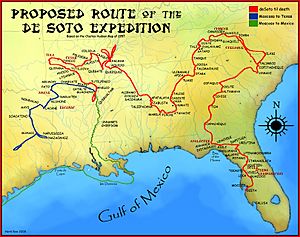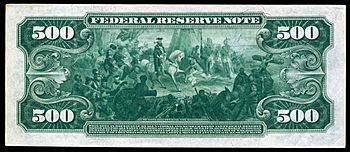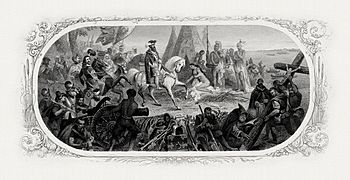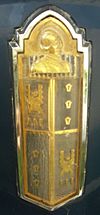Hernando de Soto facts for kids
Quick facts for kids
Hernando de Soto
|
|
|---|---|
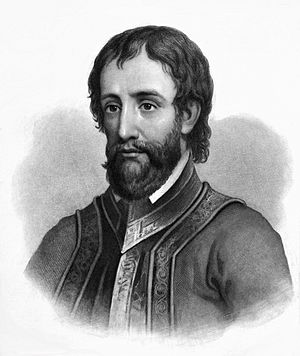 |
|
| Born | 27 October, c. 1500 |
| Died | 21 May 1542 (aged 41) Bank of Mississippi River, present-day Ferriday, Louisiana
|
| Nationality | Castilian |
| Occupation | Explorer and conquistador |
| Spouse(s) | Isabel de Bobadilla |
| Signature | |
 |
|
Hernando de Soto ( c. 1500 – 21 May 1542) was a Spanish explorer and conquistador. He led the first European expedition deep into the territory of what is now the southeastern United States in search of gold and a passage to China or the Pacific coast. De Soto was the first European to cross the Mississippi River.
Contents
Early life
Hernando de Soto was born around 1500 in Extremadura, Spain. His parents were both members of the Spanish nobility, the so-called hidalgos. From childhood, De Soto was determined to become an explorer. The region was poor and young people looked for ways to seek their fortune elsewhere, especially after Christopher Columbus's discovery of new lands.
In the New World
De Soto sailed to the New World with Pedro Arias Dávila, appointed as the first Governor of Panama. In 1520 he participated in Gaspar de Espinosa's expedition to Veragua, and in 1524, he took part in the conquest of Nicaragua under Francisco Hernández de Córdoba. There he gained fame as a ruthlessness conquistador, an excellent horseman, fighter, and tactician.
In 1530, de Soto became a regidor of León, Nicaragua. He led an expedition up the coast of the Yucatán Peninsula searching for a passage between the Atlantic Ocean and the Pacific Ocean. The passage was crucial for trade with the Orient, the richest market in the world. The expedition was a failure, and without means to explore further, de Soto joined Francisco Pizarro shortly before his departure for the interior of present-day Peru. Pizarro quickly made de Soto one of his captains.
Conquest of Peru
De Soto led one of the three groups of mounted soldiers in the Battle of Cajamarca, which resulted in the ambush and seizure of the Inca ruler Atahualpa on November 16, 1532. The Spanish held Atahualpa captive in Cajamarca for months while his subjects paid for his ransom by filling a room with gold and silver objects. During this captivity, de Soto became friends with Atahualpa and taught him to play chess. By the time the ransom had been completed, the Spanish became alarmed by rumors of an Inca army advancing on Cajamarca. Pizarro sent de Soto with 200 soldiers to scout for the rumored army.
While de Soto was gone, the Spanish in Cajamarca decided to kill Atahualpa to prevent his rescue. De Soto returned to report that he had found no signs of an army in the area. After executing Atahualpa, Pizarro and his men headed to Cuzco, the capital of the Incan Empire. After a pitched battle with Inca troops in front of the city, the Inca army withdrew and the Spanish plundered Cuzco. There they found a lot of gold and silver. De Soto received a share of the plunder, which made him very wealthy.
By 1534, de Soto was serving as lieutenant governor of Cuzco while Pizarro was building his new capital on the coast; it later became known as Lima. In 1535 King Charles awarded Diego de Almagro, Francisco Pizarro's partner, the governorship of the southern portion of the Inca Empire. When de Almagro made plans to explore and conquer the southern part of the Inca empire (now Chile), de Soto volunteered to be his second-in-command, but de Almagro turned him down. After that de Soto packed up his treasure and returned to Spain.
Return to Spain
De Soto returned to Spain in 1536. There he received 724 marks of gold, and 17,740 pesos from the King of Spain. He married Isabel de Bobadilla, daughter of Pedrarias Dávila and a relative of a confidante of Queen Isabella.
De Soto was granted the governorship of Cuba by King Charles and was expected to colonize the North American continent for Spain within 4 years, for which his family would be given a sizable piece of land. With 620 Spanish and Portuguese volunteers, de Soto embarked from Havana on seven ships and two caravels. With tons of heavy armor and equipment, they also carried more than 500 head of livestock, including 237 horses and 200 pigs, for their planned four-year continental expedition.
De Soto's exploration of North America
Theories of de Soto's route are based on the accounts of four chroniclers of the expedition.
- The first account of the expedition to be published was by the Gentleman of Elvas, an otherwise unidentified Portuguese knight who was a member of the expedition. His chronicle was first published in 1557. An English translation by Richard Hakluyt was published in 1609.
- Luys Hernández de Biedma, the King's factor (the agent responsible for the royal property) with the expedition, wrote a report which still exists. The report was filed in the royal archives in Spain in 1544. The manuscript was translated into English by Buckingham Smith and published in 1851.
- De Soto's secretary, Rodrigo Ranjel, kept a diary, which has been lost. It was apparently used by Gonzalo Fernández de Oviedo y Valdés in writing his La historia general y natural de las Indias. Oviedo died in 1557. The part of his work containing Ranjel's diary was not published until 1851. An English translation of Ranjel's report was first published in 1904.
- The fourth chronicle is by Garcilaso de la Vega, known as El Inca (the Inca). Garcilaso de la Vega did not participate in the expedition. He wrote his account, La Florida, known in English as The Florida of the Inca, decades after the expedition, based on interviews with some survivors of the expedition. The book was first published in 1605.
The chronicles describe de Soto's trail in relation to Havana, from which they sailed; the Gulf of Mexico, which they skirted while traveling inland then turned back to later; the Atlantic Ocean, which they approached during their second year; high mountains, which they traversed immediately thereafter; and dozens of other geographic features along their way, such as large rivers and swamps, at recorded intervals. Given that the natural geography has not changed much since de Soto's time, scholars have analyzed those journals with modern topographic intelligence, to develop a more precise account of the De Soto Trail.
1539: Florida
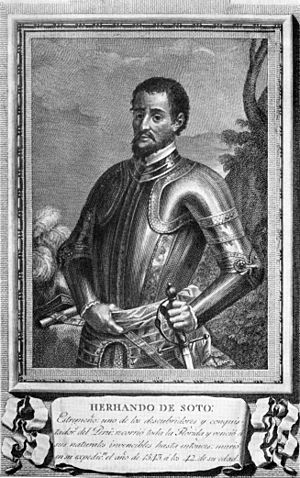
The Spanish caption reads:
"HERNANDO DE SOTO: Extremaduran, one of the discoverers and conquerors of Peru: he travelled across all of Florida and defeated its previously invincible natives, he died on his expedition in the year 1542 at the age of 42".
In May 1539, de Soto landed nine ships with over 620 men and 220 horses in an area generally identified as south Tampa Bay. Historian Robert S. Weddle has suggested that he landed at either Charlotte Harbor or San Carlos Bay. He named the land as Espíritu Santo after the Holy Spirit. The ships carried priests, craftsmen, engineers, farmers, and merchants; some with their families, some from Cuba, most from Europe and Africa. Few of the men had traveled before outside of Spain, or even away from their home villages.
Near de Soto's port, the party found Juan Ortiz, a Spaniard living with the Mocoso people. Ortiz had been captured by the Uzita while searching for the lost Narváez expedition; he later escaped to Mocoso. Ortiz had learned the Timucua language and served as an interpreter to de Soto as he traversed the Timucuan-speaking areas on his way to Apalachee.
Ortiz developed a method for guiding the expedition and communicating with the various tribes, who spoke many dialects and languages. He recruited guides from each tribe along the route. A chain of communication was established whereby a guide who had lived in close proximity to another tribal area was able to pass his information and language on to a guide from a neighboring area. Because Ortiz refused to dress as a hidalgo Spaniard, other officers questioned his motives. De Soto remained loyal to Ortiz, allowing him the freedom to dress and live among his native friends. Another important guide was the seventeen-year-old boy Perico, or Pedro, from what is now Georgia. He spoke several of the local tribes' languages and could communicate with Ortiz. Perico was taken as a guide in 1540.
The expedition traveled north, exploring Florida's West Coast, and encountering native ambushes and conflicts along the way. The army fought two battles with Timucua groups, resulting in heavy Timucua casualties. After defeating the resisting Timucuan warriors, Hernando de Soto had 200 executed, in what was to be called the Napituca Massacre, the first large-scale massacre by Europeans on what later became U.S. soil (Florida). De Soto's first winter encampment was at Anhaica, the capital of the Apalachee people. It is one of the few places on the route where archaeologists have found physical traces of the expedition.
1540: The Southeast
After hearing of gold being mined "toward the sun's rising", the expedition turned northeast through what is now the modern state of Georgia. Based on archaeological finds made in 2009 at a remote, privately owned site near the Ocmulgee River, researchers believe that de Soto's expedition stopped in Telfair County.
The expedition continued to present-day South Carolina. There the expedition recorded being received by a female chief (Cofitachequi), who gave her tribe's pearls, food and other goods to the Spanish soldiers. The expedition found no gold, however, other than pieces from an earlier coastal expedition (presumably that of Lucas Vázquez de Ayllón.)
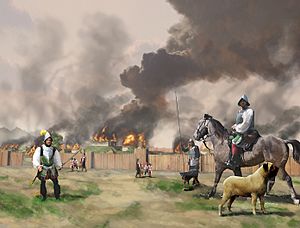
De Soto headed north into the Appalachian Mountains of present-day western North Carolina, where he spent a month resting the horses while his men searched for gold. De Soto next entered eastern Tennessee. At this point, De Soto either continued along the Tennessee River to enter Alabama from the north (according to John R. Swanton), or turned south and entered northern Georgia (according to Charles M. Hudson). The route that Swanton proposed in 1939 is still generally accepted by most archaeologists and by the U.S. government as the route of the de Soto expedition.
De Soto's expedition spent another month in the Coosa chiefdom a vassal to Tuskaloosa, who was the paramount chief, believed to have been connected to the large and complex Mississippian culture, which extended throughout the Mississippi Valley and its tributaries. De Soto turned south toward the Gulf of Mexico to meet two ships bearing fresh supplies from Havana. De Soto demanded servants, and when Tuskaloosa refused, the European explorers took him hostage. The expedition began making plans to leave the next day, and Tuskaloosa gave in to de Soto's demands, providing bearers for the Spaniards. De Soto gave the chief a pair of boots and a red cloak to reward him for his cooperation. The Mobilian tribe, under chief Tuskaloosa, ambushed de Soto's army. Other sources suggest de Soto's men were attacked after attempting to force their way into a cabin occupied by Tuskaloosa. The Spaniards fought their way out, and retaliated by burning the town to the ground. During the nine-hour encounter, about 200 Spaniards died, and 150 more were badly wounded, according to the chronicler Elvas. Twenty more died during the next few weeks. They killed an estimated 2,000-6,000 warriors at Mabila, making the battle one of the bloodiest in recorded North American history.
The Spaniards won, but they had lost most of their possessions and nearly one-quarter of their horses. The Spaniards were wounded and sickened, surrounded by enemies and without equipment in an unknown territory. Fearing that word of this would reach Spain if his men reached the ships at Mobile Bay, de Soto led them away from the Gulf Coast. He moved into inland Mississippi, most likely near present-day Tupelo, where they spent the winter.
1541: Westward
On 8 May, 1541, de Soto's troops reached the Mississippi River.
De Soto had little interest in the river, which in his view was an obstacle to his mission. There has been considerable research into the exact location where de Soto crossed the Mississippi River. A commission appointed by Franklin D. Roosevelt in 1935 determined that Sunflower Landing, Mississippi, was the "most likely" crossing place. De Soto possibly traveled down Charley's Trace, which had been used as a trail through the swamps of the Mississippi Delta, to reach the Mississippi River. De Soto and his men spent a month building flatboats, and crossed the river at night to avoid the Native Americans who were patrolling the river. De Soto had hostile relations with the native people in this area.
In the late 20th century, research suggests other locations may have been the site of de Soto's crossing, including three locations in Mississippi: Commerce, Friars Point, and Walls, as well as Memphis, Tennessee. Once across the river, the expedition continued traveling westward through modern-day Arkansas, Oklahoma, and Texas. They wintered in Autiamique, on the Arkansas River.
After a harsh winter, the Spanish expedition decamped and moved on more erratically. Their interpreter Juan Ortiz had died, making it more difficult for them to get directions and food sources, and generally to communicate with the Natives. The expedition went as far inland as the Caddo River, where they clashed with a Native American tribe called the Tula in October 1541. The Spaniards characterized them as the most skilled and dangerous warriors they had encountered. This may have happened in the area of present-day Caddo Gap, Arkansas (a monument to the de Soto expedition was erected in that community). Eventually, the Spaniards returned to the Mississippi River.
Death
De Soto died of a fever on 21 May, 1542, in the native village of Guachoya (historical sources disagree as to whether de Soto died near present-day McArthur, Arkansas, or in Louisiana) on the western bank of the Mississippi. Louisiana erected a historical marker at the estimated site.
Before his death, de Soto chose Luis de Moscoso Alvarado, his former maestro de campo (or field commander), to assume command of the expedition.
Return of the expedition to Mexico City
De Soto's expedition had explored La Florida for three years without finding the expected treasures or a hospitable site for colonization. They had lost nearly half their men, and most of the horses. By this time, the soldiers were wearing animal skins for clothing. Many were injured and in poor health. The leaders came to a consensus (although not total) to end the expedition and try to find a way home, either down the Mississippi River, or overland across Texas to the Spanish colony of Mexico City.
They decided that building boats would be too difficult and time-consuming, and that navigating the Gulf of Mexico was too risky, so they headed overland to the southwest. Eventually they reached a region in present-day Texas that was dry. The native populations were made up mostly of subsistence hunter-gatherers. The soldiers found no villages to raid for food, and the army was still too large to live off the land. They were forced to backtrack to the more developed agricultural regions along the Mississippi, where they began building seven bergantines, or pinnaces. They melted down all the iron, including horse tackle and slave shackles, to make nails for the boats. They survived through the winter, and the spring floods delayed them another two months. By July they set off on their makeshift boats down the Mississippi for the coast.
Taking about two weeks to make the journey, the expedition encountered hostile fleets of war canoes along the whole course. The first was led by the powerful paramount chief Quigualtam, whose fleet followed the boats, shooting arrows at the soldiers for days on end as they drifted through their territory. The Spanish had no effective offensive weapons on the water, as their crossbows had long ceased working. They relied on armor and sleeping mats to block the arrows. About 11 Spaniards were killed along this stretch and many more wounded.
On reaching the mouth of the Mississippi, they stayed close to the Gulf shore heading south and west. After about 50 days, they made it to the Pánuco River and the Spanish frontier town of Pánuco. There they rested for about a month. During this time many of the Spaniards, having safely returned and reflecting on their accomplishments, decided they had left La Florida too soon. But, after they reached Mexico City and Viceroy Don Antonio de Mendoza offered to lead another expedition to La Florida, few of the survivors volunteered. Of the recorded 700 participants at the start, between 300 and 350 survived (311 is a commonly accepted figure). Most of the men stayed in the New World, settling in Mexico, Peru, Cuba, and other Spanish colonies.
Effects of expedition in North America
The Spanish believed that de Soto's excursion to Florida was a failure. They didn't find any gold and founded no colonies. However, the records of the expedition contributed greatly to European knowledge about the geography, biology, and ethnology of the New World. They are the only European accounts of the culture and habits of North American native tribes before these peoples encountered other Europeans. De Soto's men were both the first and nearly the last Europeans to witness the villages and civilization of the Mississippian culture.
In addition, De Soto's expedition claimed large parts of North America for Spain. After the expedition, the Spanish concentrated their missions in the state of Florida and along the Pacific coast.
The expedition also contributed to the process of the Columbian Exchange. For instance, some of the swine brought by de Soto escaped and became the ancestors of feral razorback pigs in the southeastern United States.
De Soto was instrumental in contributing to the development of a hostile relationship between many Native American tribes and Europeans. When his expedition encountered hostile natives in the new lands, more often than not it was his men who instigated the clashes.
The expedition had a negative impact on the indigenous people. Because the locals lacked the immunity which the Europeans had acquired through generations of exposure to Eurasian diseases, the Native Americans may have suffered epidemics of illness after exposure to such diseases as measles, smallpox, and chicken pox. Several areas traversed by the expedition became depopulated, potentially by disease caused by contact with the Europeans.
Interesting facts about Hernando de Soto
- Three towns—Badajoz, Barcarrota and Jerez de los Caballeros—claim to be de Soto's birthplace.
- In his will, De Soto wanted his body to be interred at Jerez de los Caballeros, where other members of his family were buried. However, the actual site of de Soto's burial is not known. As de Soto wanted the locals to believe that he was a deity to gain their submission without conflict, he called himself an "immortal Son of the Sun." After de Soto had died, his men were anxious to conceal the fact of his death. According to one source, de Soto's men hid his body in blankets weighted with sand and sank it in the middle of the Mississippi River during the night.
- DeSoto Site Historic State Park is a Florida state park located in Tallahassee, Florida. It consists of 5 acres (20,000 m2) of land near Apalachee Parkway. The site is intended to initiate research and education on nearly four centuries of recorded history beginning with Hernando de Soto's use of the site as a winter encampment in 1539.
- At the time of death, de Soto owned four Indian slaves, three horses, and 700 hogs.
Namesakes
Many parks, towns, counties, and institutions have been named after Hernando de Soto, to include:
Places
- De Soto, Georgia
- De Soto, Illinois
- De Soto, Iowa
- De Soto, Kansas
- De Soto, Mississippi
- De Soto, Missouri
- De Soto, Nebraska
- De Soto, Wisconsin
- DeSoto, Texas
- DeSoto Caverns, Alabama
- DeSoto County, Florida
- DeSoto County, Mississippi, and its county seat, Hernando
- DeSoto Falls, in DeSoto State Park, Alabama
- DeSoto Falls, in Lumpkin County, Georgia
- DeSoto Lake, Georgia
- De Soto National Forest, in Mississippi
- De Soto National Memorial, near Bradenton, Florida, marks the possible location of Espiritu Santo, the point of disembarkation for the expedition.
- DeSoto Parish, Louisiana
- DeSoto Site Historic State Park, Florida
- DeSoto State Park, Alabama
- Fort De Soto Park in Pinellas County, Florida, named in turn for the 19th-century coastal fortifications at the site
- Hernando, Mississippi
- Hernando, Florida
- Hernando County, Florida
Other
- DeSoto automobile line developed by the Chrysler Corporation
- De Soto Heritage Festival
- DeSoto Central High School, in Southaven, Mississippi
- DeSoto County High School, in Arcadia, Florida
- DeSoto Hilton Hotel, Savannah, Georgia
- De Soto High School, in De Soto, Kansas
- De Soto High School, in De Soto, Missouri
- DeSoto High School, in DeSoto, Texas
- De Soto High School, in De Soto, Wisconsin
- Hernando de Soto Bridge, which carries Interstate 40 across the Mississippi River at Memphis (opened in 1973)
- PS 130, Hernando Desoto, a public school in New York City
- The De Soto School, a private school in Helena, Arkansas
- USS De Soto (1859), a Navy steamer that served during the American Civil War and in the West Indies.
- USS De Soto (1860), a riverboat that was renamed General Lyon on 24 October 1862.
- USS DeSoto County (LST-1171)
See also
 In Spanish: Hernando de Soto para niños
In Spanish: Hernando de Soto para niños


